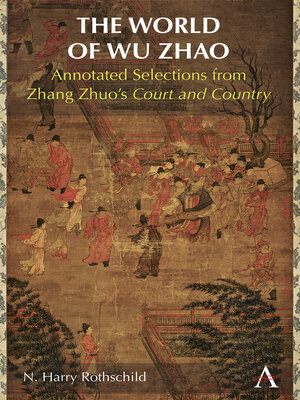The World of Wu Zhao
ebook ∣ Annotated Selections from Zhang Zhuo's Court and Country
By N. Harry Rothschild

Sign up to save your library
With an OverDrive account, you can save your favorite libraries for at-a-glance information about availability. Find out more about OverDrive accounts.
Find this title in Libby, the library reading app by OverDrive.



Search for a digital library with this title
Title found at these libraries:
| Library Name | Distance |
|---|---|
| Loading... |
This annotated translation of Zhang Zhuo's collection of miscellany, Court and Country, offers a lively, folksy, and novel perspective on the empire of Wu Zhao, China's first and only female emperor, that will amuse and shock readers, prompting them to recalibrate everything they think they know about medieval China. The World of Wu Zhao includes separate chapters on a number of different themes and topics: Buddhist and Daoist monks, the female emperor's male favorites (who dressed up in rainbow feathered garments and pranced around her court astride wooden red-capped cranes), cruel officials (bloodthirsty henchmen who took an aesthetic delight in their vocation), as well as sections on flora and fauna, the common folk, artisans and craftsmen, the military, spirits and the supernatural, the borderlands, and local officials.
|The World of Wu Zhao is a carefully curated set of more than 120 translated stories—all annotated and contextualized—on a range of topics from Zhang Zhuo's 張鷟 eighth century collection of miscellany, Collected Records of Court and Country (Chaoye qianzai 朝野僉載). The book provides English readers with a sense and feel for the empire during the reign of Wu Zhao 武曌 (624–705, also known as Empress Wu and Wu Zetian), China's first and only female emperor.
The World of Wu Zhao moves outward from the female sovereign's personal and intimate domain of the inner palace. The text includes chapters on a number of different themes and topics: the female emperor's male favorites, the culture of the court , cruel officials, as well as sections on flora and fauna, the common folk, artisans and craftsmen, Buddhist and Daoist monks, the military, spirits and the supernatural, the borderlands, and local officials. Chapters are introduced through "speaking artifacts" such as saddles, swords, bronze tallies, porcelain figurines of camels and grooms, official tallies, Buddhist cave paintings and funerary monuments—contemporary to the reign of the female emperor. This lively and fresh perspective on medieval China will amuse and shock readers, prompting them to recalibrate everything they think they know about medieval China.







